
Juncaceae is a family of flowering plants, commonly known as the rush family. It consists of 8 genera and about 464 known species of slow-growing, rhizomatous, herbaceous monocotyledonous plants that may superficially resemble grasses and sedges. They often grow on infertile soils in a wide range of moisture conditions. The best-known and largest genus is Juncus. Most of the Juncus species grow exclusively in wetland habitats. A few rushes, such as Juncus bufonius are annuals, but most are perennials.

Juncus articulatus is a flowering plant species in the rush family Juncaceae. It is known by the common name jointleaf rush or jointed rush, which can also refer to J. kraussii from Australia. It is native to Eurasia, Canada, Greenland, and much of the United States. It grows in moist areas, such as wet sand, and thrives in calcareous soils. J. articulatus was found to be more sensitive to drought and salt stress than its congeners J. acutus and J. maritimus. It is a perennial herb producing mainly erect stems from a short rhizome. The stem may root at nodes, and it generally has one or more flattened hollow cylindrical leaves up to 10 centimeters long. Transverse internal partitions or joints may be seen or felt in the leaf of the plant.
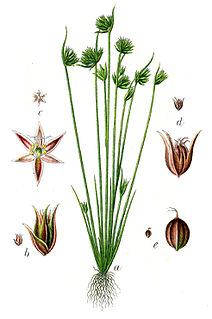
Juncus capitatus is a species of rush known by the common names dwarf rush and leafybract dwarf rush. It is native to Europe, Asia and North Africa. It is also an introduced species in parts of North America such as California and the Gulf Coast. It grows in moist areas, such as wet sand, vernal pools, and ditches.

Juncus mertensianus is a species of rush known by the common name Mertens' rush or Alaska rush. It is native to much of western North America from Alaska to Saskatchewan to New Mexico, where it grows in wet mountainous areas such as riverbanks and alpine meadows. This is a clumping perennial herb growing from a vertical rhizome. Its smooth, flat stems grow to a maximum height near 40 centimeters. Its few leaves are located at the base and also along the stem. The inflorescence is made up of usually one cluster of many flowers. Each flower has shiny dark brown to black tepals 3 to 4 millimeters long, six stamens with yellowish anthers, and long reddish stigmas, as in image at left. The fruit is a dark, oblong capsule, as in image at right.
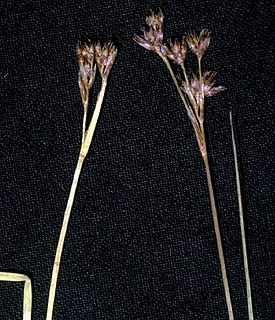
Juncus nevadensis is a species of rush known by the common name Sierra rush. It is native to much of western North America from British Columbia to New Mexico, where it grows in wet areas in many habitat types. This is a rhizomatous perennial herb which varies in appearance. Its thin, smooth stems reach a maximum height between 10 and 70 centimeters. The thin green leaves may be up to 30 centimeters long. The inflorescences generally contain a number of flowers, with each flower bearing dark to very light brown tepals, six stamens with large anthers, and very long stigmas. The fruit is a shiny chestnut brown capsule.
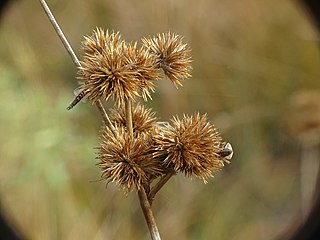
Juncus torreyi is a species of rush known by the common name Torrey's rush. It is native to North America, where it is widespread. It can be found in many habitats across the southern half of Canada, coast to coast in the United States, and throughout northern Mexico. This is a perennial herb growing from rhizomes with associated tiny tubers. The smooth stems vary in maximum height from 30 centimeters to around a meter. The leaves are green to pink or red and up to 30 centimeters long. The inflorescences have many dense, rounded clusters of up to 100 flowers each. The flower has narrow, pointed greenish, tan, or reddish tepals and six stamens. The fruit is a pointed brown capsule.
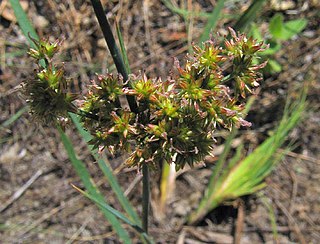
Juncus xiphioides is a species of rush known by the common name irisleaf rush.

Juncus acuminatus is a species of rush known by the common names tapertip rush, tufted rush and sharp-fruited rush. It is native to North and Central America, where it can be found in and around water bodies from central Canada to Honduras. It is a rhizomatous perennial herb forming clumps up to about 80 centimeters tall. The inflorescence is an open array of many clusters of up to 20 flowers each. The flower has pointed segments a few millimeters long which may be light reddish brown to greenish in color.
Juncus hemiendytus is a species of rush known by the common name Herman's dwarf rush. It is native to the western United States, where it grows in moist places, especially areas that are wet in spring, such as vernal pools. This is a very small annual herb forming dense clumps of hair-thin reddish stems no more than about 3 centimeters tall. The tiny, thready leaves surrounding the stems are up to about 2 centimeters long. Each stem usually bears one reddish flower, which is made up of segments 2 or 3 millimeters long curving around the developing fruit.

Juncus macrophyllus is a species of rush known by the common name longleaf rush.
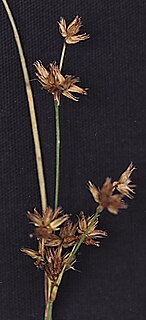
Juncus nodosus is a species of rush known by the common name knotted rush. It is native to much of North America from northern Canada to central Mexico, where it grows in wet places from freshwater to salt marsh habitat. This is a rhizomatous perennial herb producing slender, smooth stems up to about 60 centimeters tall. The inflorescence is a series of spherical clusters of flowers. Each flower has green or brown pointed segments each a few millimeters long and tapering to a point.
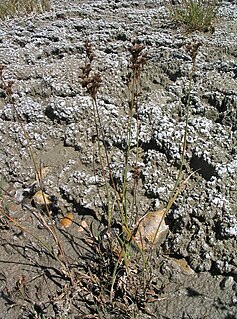
Juncus saximontanus is a species of rush known by the common name Rocky Mountain rush. It is native to much of western North America from Alaska to central Mexico, where it grows in wet habitat, often in mountainous areas, such as bogs and moist meadows.
Juncus tiehmii is a species of rush known by the common name Nevada rush. It is native to the western United States, where it grows in wet habitat with granite sand substrate, including riverbanks and barren seeps. This is a small annual herb forming dense clumps of hair-thin stems no more than about 6 centimeters high. The inflorescence is made up of one to seven tiny flowers atop each stem. The flowers have a few greenish to pink or red segments no more than about 3 millimeters long.
Juncus triformis is an uncommon species of rush known by the common names Yosemite dwarf rush and long-styled dwarf rush.
Machaeranthera juncea is a species of flowering plant in the aster family known by the common names rush bristleweed or rush-like bristleweed. It is native to northern Mexico and it occurs in the United States only as far north as San Diego County, California. It grows in coastal and inland slopes and canyons. It is a perennial herb growing erect to 1 m in height. The linear leaves are mostly located at the base of the plant, each 1–2 cm long and toothed or cut into bristle-tipped lobes. The inflorescence bears one or more flower heads lined with glandular, bristle-tipped phyllaries. The head has a center of many yellow disc florets and a fringe of 15 to 25 yellow ray florets each about 1/2 cm long. The fruit is a hairy achene 2–3 mm long tipped with a pappus.
Juncus digitatus is a rare species of rush known by the common name finger rush. It is endemic to Shasta County, California, where it is known from only two occurrences near Shingletown. It occurs in spring-moist habitat such as vernal pools in sunny locations in the foothills of the southernmost Cascade Range. The plant was first collected in 1991 and described to science as a new species in 2008.
Persoonia cordifolia is a species of flowering plant in the family Proteaceae and is endemic to a restricted area in the south of Western Australia. It is an erect, rounded to spreading shrub with smooth, mottled grey bark, broadly heart-shaped leaves and bright yellow flowers borne in groups of two to eight along a rachis up to 25 mm (0.98 in) long.

Serruria fasciflora or common pin spiderhead is a species of flowering plant in the family Proteaceae. It is a sprawling to upright shrublet of 40 cm to 1 m high and about ½ m wide. It has finely divided, upward curving leaves with thread-thin segments and clusters of sweetly scented heads, each consisting of five to seven silvery pink flowers, that may be found year-round, but mostly from May to December. It is a rather widespread and common species, that is restricted to the south of the Western Cape province of South Africa.

Leucospermum harpagonatum is an evergreen trailing shrublet with leathery, line-shaped, upright leaves and small heads with eight to ten cream, later carmine-colored, strongly incurved flowers assigned to the family Proteaceae. It is reminiscent of the hottentot fig without its flowers. It is called McGregor pincushion in English and flowers from late August till early November. It is critically endangered and occurs only in a very small area in the Western Cape province, South Africa.
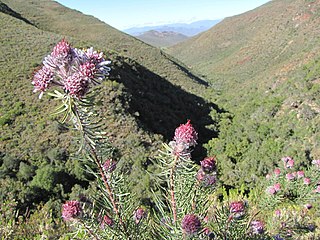
Vexatorella latebrosa, also known as the Robertson vexator, is an evergreen, upright shrub of up to about 1½ m high, from the family Proteaceae. It has entire, long inverted egg-shaped, bluish grey, leathery leaves that are line-shaped to very narrowly spade-shaped in outline, 5–6½ cm (2.0–2.6 in) long and 2–3 mm (0.08–0.12 in), and mostly solitary globular flower heads at the end of the branches of 2½–3 cm (0.8 in) across with scented, pink to carmine flowers with extended, styles with a thickened tip. The plants are flowering from August to September. It is an endemic species that is restricted to the Western Cape province of South Africa.














